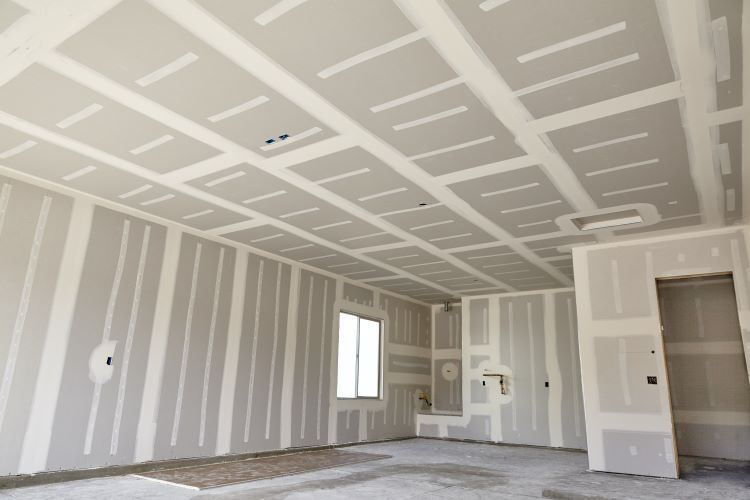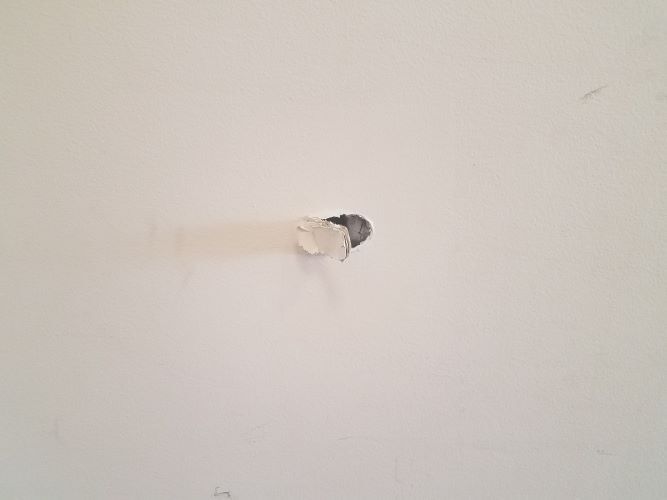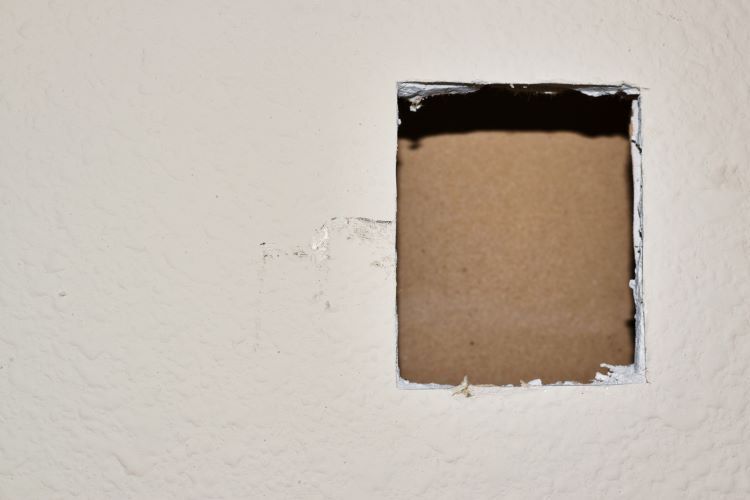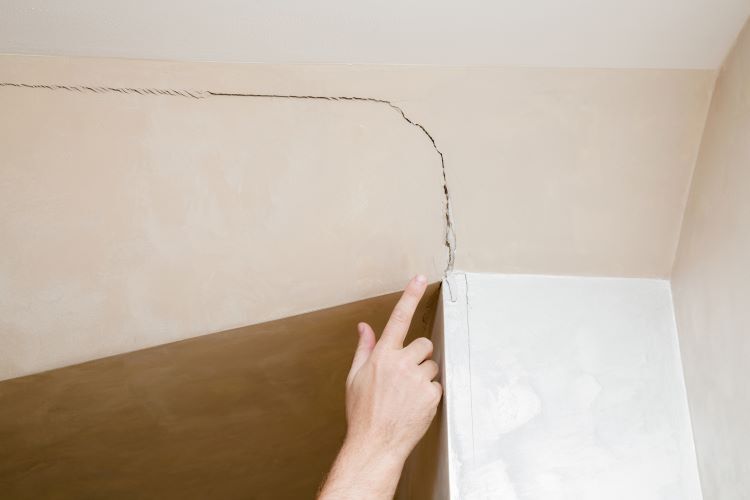Drywall Repair Services
What are the different types of drywall repairs?
Having an imperfection to the surface of your wall or ceiling can be considered a damaged drywall section that will require a drywall repair. There can be different types of damage to your drywall, and the specific type of imperfection can have varying looks and as a result they will need to be handled in a manner that is suitable to the damaged area. What exactly are these types of damaged sections you may ask? Well we are happy to cover them below. We will also go over how these repairs are done in a bit more detail further below so you can have more information regarding these types of drywall services.
At London Drywallers we believe in empowering our community by extending our knowledge and experience to further educate and benefit the people of this great region where we serve. From minor holes to major ceiling repair, our team can fix it all. Please continue to browse our site for any of your drywalling needs, or feel free to contact us at anytime, we would love to have a conversation with you. And of course if you need a service right away, then give us a call and we got you covered!
-Wall Dings
These are the most common types of drywall imperfections. A wall ding is usually an area that has been hit, or "dinged" by an object. A great example of this would be when a piece of furniture is being moved, and a corner of the furniture bangs into the wall, causing what will look like a dent to the surface of the wall. These are considered a minor repair and can normally be fixed quite easily on your own.
-Drywall Holes
A drywall hole is exactly as it sounds. An unsightly hole in the surface of your wall or ceiling. There can be many different causes to having a hole in your wall or ceiling. Similar to wall dings, holes can commonly be caused when moving furniture or other large and awkward items. However, unlike a wall ding, a hole is obviously where the object coming into contact with the drywall goes right through it, causing an immediate hole. The size and location of the hole will determine the difficulty of repair.
-Drywall Cracks
Cracks to your drywall are quite different compared to dings or holes. Unlike holes and wall dings which are caused by an impact to the surface, a crack is generally formed over an elongated period of time. Cracks in drywall are usually caused by stress to the home or building nearby the area that has a crack. Quite often this is the result of home settling in place and is not a reason for concern. Cracks require a more skilled approach to be efficiently repaired. If you've experience a crack to your ceiling or wall, please don't hesitate and give us a call!
Having an imperfection to the surface of your wall or ceiling can be considered a damaged drywall section that will require a repair. There can be different types of damage to your drywall, and the specific type of imperfection can have varying looks and as a result they will need to be handled in a manner that is suitable to the damaged area. What exactly are these types of damaged sections you may ask? Well we are happy to cover them below. We will also go over how these repairs are done in a bit more detail further below so you can have more information regarding these types of drywall services. At London Drywallers we believe in empowering our community by extending our knowledge and experience to further educate and benefit the people of this great region where we serve. Please continue to browse our site for any of your drywalling needs, or feel free to contact us at anytime, we would love to have a conversation with you. And of course if you need a service right away, then give us a call and we got you covered!
-Wall Dings
These are the most common types of drywall imperfections. A wall ding is usually an area that has been hit, or "dinged" by an object. A great example of this would be when a piece of furniture is being moved, and a corner of the furniture bangs into the wall, causing what will look like a dent to the surface of the wall. These are considered a minor repair and can normally be fixed quite easily on your own.
-Drywall Holes
A drywall hole is exactly as it sounds. An unsightly hole in the surface of your wall or ceiling. There can be many different causes to having a hole in your wall or ceiling. Similar to wall dings, holes can commonly be caused when moving furniture or other large and awkward items. However, unlike a wall ding, a hole is obviously where the object coming into contact with the drywall goes right through it, causing an immediate hole. The size and location of the hole will determine the difficulty of repair.
-Drywall Cracks
Cracks to your drywall are quite different compared to dings or holes. Unlike holes and wall dings which are caused by an impact to the surface, a crack is generally formed over an elongated period of time. Cracks in drywall are usually caused by stress to the home or building nearby the area that has a crack. Quite often this is the result of home settling in place and is not a reason for concern. Cracks require a more skilled approach to be efficiently repaired. If you've experience a crack to your ceiling or wall, please don't hesitate and give us a call!
From dings to holes, to full on cracks splintering across your walls or ceilings. Whatever the repair, if it is drywall related then our team is here to help!
Request a free estimate!
We will get back to you as soon as possible.
Please try again later.
How to repair damaged drywall
Repairing a drywall dent (ding)
Fixing up a ding to your wall or perhaps your ceiling is generally an easy and quick fix. You can perform this on your own with the following steps, and you will require drywall mud, a taping knife, and sandpaper.
- First you will need to smear the drywalling compound across the dent using a taping knife. Make sure to completely and excessively fill the dent so that the mudding is protruding off the wall like a bump. Allow at least 24 hours for dry time.
- Once it has completely dried, you will need to sand it down. We recommend using a coarse piece of sandpaper to start with in order to remove the majority of the dried compound, but not all of it.
- Switch to a fine piece of sandpaper to smoothly sand down the dried compound so that is blends in flat with the surface. You may need to repeat steps 1-2 depending on the size of the dent.
- Once that ding in your wall has been smoothed over you're done! You will simply need to paint over the section to blend it in with the rest of the surface.
Fixing up a ding to your wall or perhaps your ceiling is generally an easy and quick fix. You can perform this on your own with the following steps, and you will require drywall mud, a taping knife, and sandpaper.
- First you will need to smear the drywalling compound across the dent using a taping knife. Make sure to completely and excessively fill the dent so that the mudding is protruding off the wall like a bump. Allow at least 24 hours for dry time.
- Once it has completely dried, you will need to sand it down. We recommend using a coarse piece of sandpaper to start with in order to remove the majority of the dried compound, but not all of it.
- Switch to a fine piece of sandpaper to smoothly sand down the dried compound so that is blends in flat with the surface. You may need to repeat steps 1-2 depending on the size of the dent.
- Once that ding in your wall has been smoothed over you're done! You will simply need to paint over the section to blend it in with the rest of the surface.
How to repair a crack to drywall
The appearance of a crack in your drywall can be an unsettling look to say the least. The thought of repairing these cracks can become intimidating as well if you have never had experience in dealing with one. We're happy to tell you that not all cracks need a serious repair! If you have a very minor looking crack that does not appear to go very deep, then we suggest trying to simply paint over the crack. This may not fix it, and the crack could come back within a short period of time. But there are instances where merely throwing some paint over it will fix it for good. If its a small crack then try this out before spending any money on further tools or materials, it could possibly save you some cash!
For cracks that unfortunately require a more serious approach, do not be alarmed! The process is not incredibly difficult, but it does however require the right tools and a little bit of know how. One important detail to make known is that when it comes to a drywall crack in need of a repair, do not simply cover it with joint compound and hope for the best, the crack will come back. Cracks need a strip of adhesive fiber glass tape to be applied along the entire length of the crack. Once the entire area has been covered with the tape, it will need to be mudded and sanded several times until a smooth finish is blended onto the surface. If you have questions about a crack you've discovered somewhere in your home or place of business then get in touch with us today, we're here to help!
The appearance of a crack in your drywall can be an unsettling look to say the least. The thought of repairing these cracks can become intimidating as well if you have never had experience in dealing with one. We're happy to tell you that not all cracks need a serious repair! If you have a very minor looking crack that does not appear to go very deep, then we suggest trying to simply paint over the crack. This may not fix it, and the crack could come back within a short period of time. But there are instances where merely throwing some paint over it will fix it for good. If its a small crack then try this out before spending any money on further tools or materials, it could possibly save you some cash!
For cracks that unfortunately require a more serious approach, do not be alarmed! The process is not incredibly difficult, but it does however require the right tools and a little bit of know how. One important detail to make known is that when it comes to a drywall crack in need of a repair, do not simply cover it with joint compound and hope for the best, the crack will come back. Cracks need a strip of adhesive fiber glass tape to be applied along the entire length of the crack. Once the entire area has been covered with the tape, it will need to be mudded and sanded several times until a smooth finish is blended onto the surface. If you have questions about a crack you've discovered somewhere in your home or place of business then get in touch with us today, we're here to help!
Patching a hole in drywall
Repairing a complete hole to your drywall can become more of a complex situation than fixing a simple ding to the wall. If the puncture through the surface of the drywall is smaller than 4 inches then it will need to be taped over with self adhesive fiber glass tape. Once the tape is smoothly covering the entire surface area of the hole, you will need to mud and sand over the damaged area, similar to the steps used to fixing a ding in a wall. This type of repair requires the right tools, as well as a certain level of hands on experience to get it right. If you have questions regarding this process, or if you would rather we come out to do a repair for you, please get in touch with us today, we would love to hear from you.
For holes 4 inches or bigger the method of repair becomes slightly more complicated. This requires the damaged piece of drywall to be completely cut out, and will then need to be replaced with a new plasterboard sheet cut to size in order to fill in the cut out section. Prior to installing the new custom sized sheet, a wooden stud will need to be installed behind the wall for the new drywall sheet to be attached to. Upon successfully installing the new section, the 4 edges will need to be taped, and then the whole section must be mudded and sanded several times. We understand this can be a daunting task for several, and that is why our team is here and ready to help you. London Drywallers take pride in being able to help our community members who are in need of any drywall repairs, no matter the size.
Repairing a complete hole to your drywall can become more of a complex situation than fixing a simple ding to the wall. If the puncture through the surface of the drywall is smaller than 4 inches then it will need to be taped over with self adhesive fiber glass tape. Once the tape is smoothly covering the entire surface area of the hole, you will need to mud and sand over the damaged area, similar to the steps used to fixing a ding in a wall. This type of repair requires the right tools, as well as a certain level of hands on experience to get it right. If you have questions regarding this process, or if you would rather we come out to do a repair for you, please get in touch with us today, we would love to hear from you.
For holes 4 inches or bigger the method of repair becomes slightly more complicated. This requires the damaged piece of drywall to be completely cut out, and will then need to be replaced with a new plasterboard sheet cut to size in order to fill in the cut out section. Prior to installing the new custom sized sheet, a wooden stud will need to be installed behind the wall for the new drywall sheet to be attached to. Upon successfully installing the new section, the 4 edges will need to be taped, and then the whole section must be mudded and sanded several times. We understand this can be a daunting task for several, and that is why our team is here and ready to help you. London Drywallers take pride in being able to help our community members who are in need of any drywall repairs, no matter the size.

Professional. Trusted. Quality.
London Drywallers
Button




